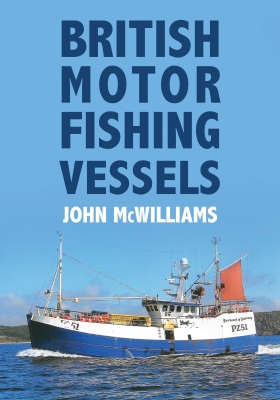 British Motor Fishing Vessels is a book covering the many different types of motorised fishing boats which have been used by commercial fishermen around Britain. It was published in 2018. The short introduction explains how sailing fishing boats died out in the 1800s and were replaced by motorised fishing vessels. In the introduction McWilliams explains that the design of modern fishing boats is becoming standardised. This means that the huge variety of different types of motorised boats which have been used by British fishermen will be lost if efforts are not made to document and record the history of the different vessels. The rest of the book is then based on detailed profiles of the different types of boats which have been used by British fishermen in the past and present. Technical aspects of the vessels (such as the size, horsepower of the engines and type of fishing the vessel was designed for) are combined with aspects of the social history of the vessels to create a fully rounded view of each boat. In some cases specific examples of boats which have been built are given, along with further information such as the year in which they were built.
British Motor Fishing Vessels is a book covering the many different types of motorised fishing boats which have been used by commercial fishermen around Britain. It was published in 2018. The short introduction explains how sailing fishing boats died out in the 1800s and were replaced by motorised fishing vessels. In the introduction McWilliams explains that the design of modern fishing boats is becoming standardised. This means that the huge variety of different types of motorised boats which have been used by British fishermen will be lost if efforts are not made to document and record the history of the different vessels. The rest of the book is then based on detailed profiles of the different types of boats which have been used by British fishermen in the past and present. Technical aspects of the vessels (such as the size, horsepower of the engines and type of fishing the vessel was designed for) are combined with aspects of the social history of the vessels to create a fully rounded view of each boat. In some cases specific examples of boats which have been built are given, along with further information such as the year in which they were built.
A wide variety of boats are covered, ranging from small punts to very large trawlers. Similarly, boats dating back to the 1800s are covered, along with modern vessels built in the late 1990s. Technical language for parts of boats and types of fishing is sometimes used with little explanation (something which may confuse readers who are unfamiliar with technical terms), but the clarity of the descriptions and the clear drawings and black and white photos of each vessel means that a general non-specialist reader can still understand this book, and may well be introduced to some new fishing related terms they were not aware of before. Interesting facts are woven into the profiles of the different boats, such as the fact that some wartime axillary vessels were specifically built with features which would make them easier to sell as fishing vessels after the war. One issue with the book which may slightly grate with readers is that both imperial and metric units are both used to describe the technical aspects of vessels in a seemingly random manner. For example, the small Hastings punt is described as being 16ft long with no imperial units given, but we are told that a large beam trawler is 31.8 metres in length, but its length in feet is not given. While most readers will overlook this (and some may not even notice) it may be slightly annoying for some readers.
The author clearly loves this subject and his enthusiasm to record the different types of fishing vessels which have been used by British fishermen comes through. This is especially true when describing boats such as cobles which are being used less and less by working fishermen but still live on as heritage boats, some of which are recently made replicas of original cobles. Many of the boats described early in the book originate from the author’s native Cornwall and the south west, but the book covers the whole of the UK with vessels originally built for areas such as the north east, Thames Estuary and Scotland described, as well as those built for other places including foreign-designed vessels such as Danish Seiners.
Overall this is an excellent book on the many different motor vessels which have been used by UK fishermen. Detailed and with clear explanations and descriptions of the vessels anyone interested in this topic will find everything they need in this book. While some aspects of a general readership may have preferred a little less of the technical aspects and a little more of the social history, people with a detailed interest in British Motor Fishing Vessels will welcome the technical information which is included. With this book the aim of remembering and recording the vast range of different vessels which have been used by UK fishermen has certainly been achieved.
British Motor Fishing Vessels can be purchased by clicking here.